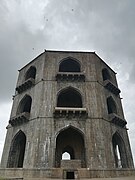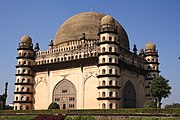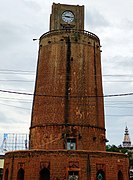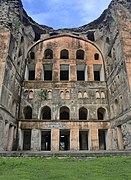A | B | C | D | E | F | G | H | CH | I | J | K | L | M | N | O | P | Q | R | S | T | U | V | W | X | Y | Z | 0 | 1 | 2 | 3 | 4 | 5 | 6 | 7 | 8 | 9
This article has multiple issues. Please help improve it or discuss these issues on the talk page. (Learn how and when to remove these template messages)
|



Deccani architecture, particularly the architecture of the Bahmani and Deccan Sultanates, is the architecture of the Deccan Plateau, and is a regional variant of Indo-Islamic architecture. It was influenced by the styles of the Delhi Sultanate and later Mughal architecture, but sometimes also influenced from Persia and Central Asia. Hindu temple architecture in the same areas had very different styles.
The Bahmani and Deccan sultanates ruled the Deccan Plateau for the majority of the 13th–17th centuries. The Deccan sultanates were five dynasties that ruled late medieval Indian kingdoms, namely the Bijapur, Golkonda, Ahmadnagar, Bidar, and Berar sultanates.
The rulers of the five Deccan sultanates and the Bahmani sultanate had a number of cultural contributions in the fields of art, music, literature and architecture. The Bidar and Golconda forts are examples of the architecture and military planning of the sultanates. Apart from forts, they also constructed many tombs, mosques and madrasas. Gol Gumbaz (tomb of Mohammed Adil Shah), was the second largest dome in the world.[when?]
In 2014, UNESCO put a group of buildings on its "tentative list" to become a World Heritage Site under the name "Monuments and Forts of the Deccan Sultanate" (despite there being multiple sultanates). These are:[1]
- Bahmani Monuments at Gulbarga, Karnataka
- Bahmani and Barid Shahi Monuments at Bidar, Karnataka
- Adil Shashi Monuments at Bijapur, Karnataka
- Qutb Shahi Monuments at Hyderabad, Telangana
Architecture of the Bahmani Sultanate





The Bahmani Sultanate constructed many architectural works, although many of them have been destroyed. Shown are some ruins showcasing their architectural legacy.[2] The Gulbarga Fort, Haft Gumbaz, and Jama Masjid in Gulbarga, Bidar Fort and Madrasa Mahmud Gawan[3] in Bidar, are the major architectural contributions.
The later rulers were buried in an elaborate tomb complex, known as the Bahmani Tombs.[4] The exterior of one of the tombs is decorated with coloured tiles. Arabic, Persian and Urdu inscriptions are inscribed inside the tombs.[4][5]
The Bahmani rulers built tombs and mosques in Bidar and Gulbarga. They also built many forts at Daulatabad, Golconda and Raichur. The architecture was influenced by Persian architecture. They invited architects from Persia, Turkey and Arabia. Some of the structures built by the Bahmanis were the Jami Masjid at Gulbarga, Chandand Minar and the Mahmud Gawan Madrasa at Bidar.[citation needed]
The Persianate Indo-Islamic style of architecture developed during this period was later adopted by the Deccan Sultanates as well.
Architecture of the Ahmadnagar Sultanate
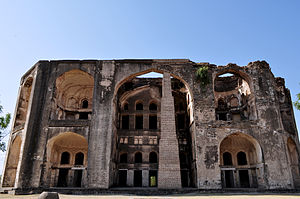
Palaces such as the Farah Bakhsh Bagh, Hasht Bihisht Bagh, and Manjarsumbah are in and around Ahmadnagar city. There exist tombs of nobles like Salabat Khan and Changiz Khan, and also of saints like Shah Sharif and Bava Bangali.[6]
Malik Ambar is credited with the construction of the Janjira Fort in the Murud Area of present-day Maharashtra India.[7] After its construction in 1567 AD, the fort was key to the Sidis withstanding various invasion attempts by the Marathas, Mughals, and Portuguese to capture Janjira.[8]
Farah Bagh (also called Faria Bagh) is situated in Ahmednagar, Maharashtra. It is a palace build by Nizam Shahi rulers in Ahmednagar.[9][10][11] Farah Bagh was the centrepiece of a palatial complex completed in 1583. It was a special possession of the royal household and Murtaza Nizam Shah often retired here to play chess with a Delhi singer whom he called Fateh Shah and also built for him a separate mahal called Lakad Mahal in the garden. [citation needed]
Architecture of the Bijapur Sultanate

Prominent monuments in Bijapur are the Gagan Mahal, Gol Gumbaz, Bijapur Fort and Ibrahim Rauza. Gol Gumbaz is the tomb of Mohammed Adil Shah and it contains the second largest dome in the world constructed before modern age. The external diameter of the hemispherical dome is 44 m. Ibrahim Rouza is the tomb for Ibrahim Adil Shah II and it is one of the most beautiful monument in Bijapur.
The Jami Masjid is one of the largest mosques in India having courtyard of 11,000 square feet. Other architectural works of this period in Bijapur are the Chini Mahal, Jal Mandir, Sat Manzil, Gagan Mahal, Anand Mahal and the Asar Mahal (1646).[12]
Architecture of the Golconda Sultanate
Golkonda fort, built by the Qutb Shahi dynasty, is one of the most impregnable forts in India. It is also known for its acoustic features and water management.
The Jami Masjid (1518) built by Quli Qutb Mulk is a notable mosque in Golkonda. The tombs of Qutb Shahis are a mausoleum complex, a royal necropolis of 30 tombs of the royal family. These were erected from 1543 to 1672.
Char Minar, in the heart of Hyderabad, was completed in 1591. It has four minarets of 56 m. height. The construction of the Makkah Masjid was started in 1617 during the reign of Muhammad Qutb Shah but completed only in 1693.[13]
Gallery
-
Tomb of Salabat Khan II
-
Gol Gumbaz
-
Bara Kaman, unfinished mausoleum of Ali Adil Shah II
-
Chaubara Tower builted by Ahmad Shah I Wali
-
Ibrahim Rouza at Bijapur, Karnataka, India
-
Mosque with 32 pillars in the Solapur Bhuikot Fort
-
Cannons located at the Solapur Fort
-
Murud Janjira Fort
-
Cannons located at Murud-Janjira Fort
-
Ruins of Faria Bagh
References
- ^ UNESCO "tentative list"
- ^ a b Datta, Rangan (6 June 2023). "Bidar Fort in Karnataka: A treasure trove of south Indian heritage". The Telegraph. My Kolkata. Retrieved 11 October 2023.
- ^ Yazdani 1947, pp. 91–98.
- ^ a b Yazdani 1947, pp. 114–142.
- ^ Sara Mondini (2016). "The Use of Quranic Inscriptions in the Bahmani Royal Mausoleums The Case of Three Tombstones from Ashtur". Eurasiatica. 4. doi:10.14277/6969-085-3/EUR-4-12.
- ^ Sohoni, Pushkar (2018). The Architecture of a Deccan Sultanate: Courtly Practice and Royal Authority in Late Medieval India. London: I.B. Tauris. ISBN 9780755606795.
- ^ Sohoni, Pushkar (2020). "The Fort of Janjira". African Rulers and Generals in India. Greensboro, North Carolina; Ahmedabad: University of North Carolina Ethiopian and East African Studies Project; Ahmedabad Sidi Heritage and Educational Center. pp. 167–183.
- ^ Kainthla, Anita (August 2011). "The Invincible Fort of Murud Janjira". India Currents. 25 (5): 56–57 – via ProQuest.
- ^ "How 16th-century Ahmednagar palace in Maharashtra stayed cool in summer". Hindustan Times. 26 May 2019. Retrieved 25 October 2019.
- ^ George Michell (1987). The New Cambridge History of India: 1. The Portuguese in India. Cambridge University Press. ISBN 0521563216. Retrieved 20 June 2013.
- ^ Singh, M.; Kumar, S Vinodh (8 May 2019). "Architechtural features and characterization of 16th century Indian Monument Farah Bagh, Ahmed Nagar, India". International Journal of Architectural Heritage. 14 (9): 1398–1411. doi:10.1080/15583058.2019.1610524. S2CID 164648431.
- ^ Michell & Zebrowski 1999, pp. 41–47, 86–98
- ^ Michell & Zebrowski 1999, pp. 47–53, 101–106
Sources
- Michell, George; Zebrowski, Mark (1999). Architecture and Art of the Deccan Sultanates (The New Cambridge History of India Vol. I:7). Cambridge: Cambridge University Press. ISBN 0-521-56321-6.
- Yazdani, Ghulam (1947). Bidar, Its History and Monuments. London: Oxford University Press.
External links
>Text je dostupný pod licencí Creative Commons Uveďte autora – Zachovejte licenci, případně za dalších podmínek. Podrobnosti naleznete na stránce Podmínky užití.
Talk:Architecture of the Bahmani and Deccan Sultanates
Help:Maintenance template removal
File:Question book-new.svg
Wikipedia:Verifiability
Special:EditPage/Architecture of the Bahmani and Deccan Sultanates
Help:Referencing for beginners
Help:Maintenance template removal
Wikipedia:Basic copyediting
Special:EditPage/Architecture of the Bahmani and Deccan Sultanates
Help:Maintenance template removal
Talk:Architecture of the Bahmani and Deccan Sultanates##
Wikipedia:GALLERY
MOS:SANDWICH
Wikipedia:Manual of Style/Images
Help:Maintenance template removal
Help:Maintenance template removal
The Architecture of a Deccan Sultanate
File:Gateway to Bidar fort.jpg
File:Complete view of Mahumad Gawan.JPG
File:Murud Janjira Fort.JPG
Bahmani Sultanate
Deccan Sultanates
Deccan Plateau
Indo-Islamic architecture
Delhi Sultanate
Mughal architecture
Persia
Central Asia
Hindu temple architecture
Medieval India
Bijapur Sultanate
Golconda Sultanate
Ahmadnagar Sultanate
Bidar Sultanate
Berar Sultanate
Bidar fort
Golconda
Mosque
Madrasa
Gol Gumbaz
Mohammed Adil Shah, Sultan of Bijapur
Wikipedia:Manual of Style/Dates and numbers#Chronological items
UNESCO
World Heritage Site
Gulbarga
Bidar
Bijapur
Hyderabad
File:Fort Garden bidar.jpg
File:Chand Minar.JPG
Daulatabad fort
File:Haft Gumbad.jpg
Haft Gumbaz
Kalaburagi
File:Protected Walls.JPG
File:Barid Shahi 05.jpg
Bidar
Gulbarga Fort
Haft Gumbaz
Jama Mosque Gulbarga
Bidar Fort
Mahmud Gawan Madrasa
Bahmani Tombs
Daulatabad Fort
Golconda
Raichur
Wikipedia:Citation needed
File:Faria Bagh Palace of second Nizam.JPG
Murud-Janjira
Maharashtra
Ahmednagar
Maharashtra
Nizam
Wikipedia:Citation needed
File:Gagan Mahal Bijapura.jpg
Bijapur
Gol Gumbaz
Bijapur Fort
Ibrahim Rauza
Mohammed Adil Shah, Sultan of Bijapur
Ibrahim Adil Shah II
Jama Masjid, Bijapur
Jal Mandir
Qutb Shahi architecture
Golkonda
Quli Qutb Mulk
Golkonda#Qutub Shahi tombs
Charminar
Hyderabad
Makkah Masjid, Hyderabad
Muhammad Qutb Shah
File:Tomb of salabat khan II .jpg
File:Gol Gumbaj2.JPG
File:Bara Kaman Bijapur.jpg
File:Choubara-Bidar-Karnataka-PhotoOne.jpg
File:Bijapur Ibrahim Rouza 100C.jpg
File:Mosque with 32 pillars.jpg
File:Inner view Bhuikot Killa.jpg
File:Murud Janjira Fort.JPG
File:Guns align on the teress of Buraj.jpg
File:Mysterious Faria Bagh.jpg
Doi (identifier)
The Architecture of a Deccan Sultanate
ISBN (identifier)
Special:BookSources/9780755606795
ISBN (identifier)
Special:BookSources/0521563216
Doi (identifier)
S2CID (identifier)
ISBN (identifier)
Special:BookSources/0-521-56321-6
Ghulam Yazdani
Oxford University Press
Frontline (magazine)
Architecture of the Bahmani and Deccan Sultanates
Architecture of the Bahmani and Deccan Sultanates
Architecture of the Bahmani and Deccan Sultanates
Main Page
Wikipedia:Contents
Portal:Current events
Special:Random
Wikipedia:About
Wikipedia:Contact us
Special:FundraiserRedirector?utm source=donate&utm medium=sidebar&utm campaign=C13 en.wikipedia.org&uselang=en
Help:Contents
Help:Introduction
Wikipedia:Community portal
Special:RecentChanges
Wikipedia:File upload wizard
Main Page
Special:Search
Help:Introduction
Special:MyContributions
Special:MyTalk
Special:EntityPage/Q24906440#sitelinks-wikipedia
Architecture of the Bahmani and Deccan Sultanates
Talk:Architecture of the Bahmani and Deccan Sultanates
Architecture of the Bahmani and Deccan Sultanates
Architecture of the Bahmani and Deccan Sultanates
Special:WhatLinksHere/Architecture of the Bahmani and Deccan Sultanates
Special:RecentChangesLinked/Architecture of the Bahmani and Deccan Sultanates
Wikipedia:File Upload Wizard
Special:SpecialPages
Special:EntityPage/Q24906440
Architecture of the Bahmani and Deccan Sultanates
Architecture of the Bahmani and Deccan Sultanates
Architecture of the Bahmani and Deccan Sultanates
Main Page
Wikipedia:Contents
Portal:Current events
Special:Random
Wikipedia:About
Wikipedia:Contact us
Special:FundraiserRedirector?utm source=donate&utm medium=sidebar&utm campaign=C13 en.wikipedia.org&uselang=en
Help:Contents
Help:Introduction
Wikipedia:Community portal
Special:RecentChanges
Wikipedia:File upload wizard
Main Page
Special:Search
Help:Introduction
Special:MyContributions
Special:MyTalk
Special:EntityPage/Q24906440#sitelinks-wikipedia
Architecture of the Bahmani and Deccan Sultanates
Talk:Architecture of the Bahmani and Deccan Sultanates
Architecture of the Bahmani and Deccan Sultanates
Architecture of the Bahmani and Deccan Sultanates
Special:WhatLinksHere/Architecture of the Bahmani and Deccan Sultanates
Special:RecentChangesLinked/Architecture of the Bahmani and Deccan Sultanates
Wikipedia:File Upload Wizard
Special:SpecialPages
Special:EntityPage/Q24906440
Architecture of the Bahmani and Deccan Sultanates
Architecture of the Bahmani and Deccan Sultanates
Architecture of the Bahmani and Deccan Sultanates
Main Page
Wikipedia:Contents
Portal:Current events
Special:Random
Wikipedia:About
Wikipedia:Contact us
Special:FundraiserRedirector?utm source=donate&utm medium=sidebar&utm campaign=C13 en.wikipedia.org&uselang=en
Help:Contents
Help:Introduction
Wikipedia:Community portal
Special:RecentChanges
Wikipedia:File upload wizard
Main Page
Special:Search
Help:Introduction
Special:MyContributions
Special:MyTalk
Special:EntityPage/Q24906440#sitelinks-wikipedia
Architecture of the Bahmani and Deccan Sultanates
Talk:Architecture of the Bahmani and Deccan Sultanates
Architecture of the Bahmani and Deccan Sultanates
Architecture of the Bahmani and Deccan Sultanates
Special:WhatLinksHere/Architecture of the Bahmani and Deccan Sultanates
Special:RecentChangesLinked/Architecture of the Bahmani and Deccan Sultanates
Wikipedia:File Upload Wizard
Special:SpecialPages
Special:EntityPage/Q24906440
Updating...x
Text je dostupný za podmienok Creative
Commons Attribution/Share-Alike License 3.0 Unported; prípadne za ďalších
podmienok.
Podrobnejšie informácie nájdete na stránke Podmienky
použitia.
